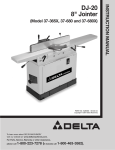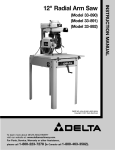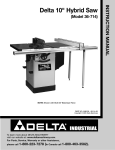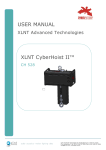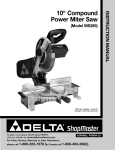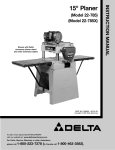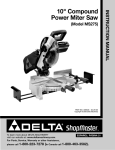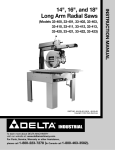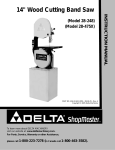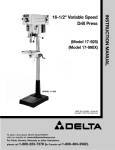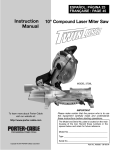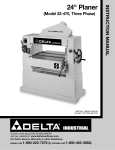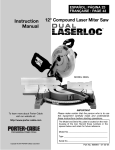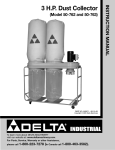Download Porter-Cable 33-891 Saw User Manual
Transcript
(Model 33-890, 33-895X, 33-891, 33-892) PART NO. 424-02-651-0025 - 03-18-05 Copyright © 2005 Delta Machinery Record this information for future reference. SERIAL NO.______________________________ DATE OF PURCHASE ____________________ To learn more about DELTA MACHINERY visit our website at: www.deltamachinery.com. For Parts, Service, Warranty or other Assistance, please call 1-800-223-7278 (In Canada call 1-800-463-3582). INSTRUCTION MANUAL 12" Radial Arm Saw TABLE OF CONTENTS IMPORTANT SAFETY INSTRUCTIONS . . . . . . . . . . . . . . . . . . . . . . . . . . . . . . . . . . . . . . . . . . . . . . . . . . . . . . . . . . .2 SAFETY GUIDELINES . . . . . . . . . . . . . . . . . . . . . . . . . . . . . . . . . . . . . . . . . . . . . . . . . . . . . . . . . . . . . . . . . . . . . . . .3 GENERAL SAFETY RULES . . . . . . . . . . . . . . . . . . . . . . . . . . . . . . . . . . . . . . . . . . . . . . . . . . . . . . . . . . . . . . . . . . . .4 ADDITIONAL SPECIFIC SAFETY RULES . . . . . . . . . . . . . . . . . . . . . . . . . . . . . . . . . . . . . . . . . . . . . . . . . . . . . . . . .5 FUNCTIONAL DESCRIPTION . . . . . . . . . . . . . . . . . . . . . . . . . . . . . . . . . . . . . . . . . . . . . . . . . . . . . . . . . . . . . . . . . .8 CARTON CONTENTS . . . . . . . . . . . . . . . . . . . . . . . . . . . . . . . . . . . . . . . . . . . . . . . . . . . . . . . . . . . . . . . . . . . . . . . . .8 ASSEMBLY . . . . . . . . . . . . . . . . . . . . . . . . . . . . . . . . . . . . . . . . . . . . . . . . . . . . . . . . . . . . . . . . . . . . . . . . . . . . . . . . .8 OPERATION . . . . . . . . . . . . . . . . . . . . . . . . . . . . . . . . . . . . . . . . . . . . . . . . . . . . . . . . . . . . . . . . . . . . . . . . . . . . . . .17 TROUBLESHOOTING . . . . . . . . . . . . . . . . . . . . . . . . . . . . . . . . . . . . . . . . . . . . . . . . . . . . . . . . . . . . . . . . . . . . . . .28 MAINTENANCE . . . . . . . . . . . . . . . . . . . . . . . . . . . . . . . . . . . . . . . . . . . . . . . . . . . . . . . . . . . . . . . . . . . . . . . . . . . . .28 SERVICE . . . . . . . . . . . . . . . . . . . . . . . . . . . . . . . . . . . . . . . . . . . . . . . . . . . . . . . . . . . . . . . . . . . . . . . . . . . . . . . . . .29 ACCESSORIES . . . . . . . . . . . . . . . . . . . . . . . . . . . . . . . . . . . . . . . . . . . . . . . . . . . . . . . . . . . . . . . . . . . . . . . . . . . .29 WARRANTY . . . . . . . . . . . . . . . . . . . . . . . . . . . . . . . . . . . . . . . . . . . . . . . . . . . . . . . . . . . . . . . . . . . . . . . . . . . . . . . .29 SERVICE CENTER LOCATIONS . . . . . . . . . . . . . . . . . . . . . . . . . . . . . . . . . . . . . . . . . . . . . . . . . . . . . . . .back cover IMPORTANT SAFETY INSTRUCTIONS Read and understand all warnings and operating instructions before using any tool or equipment. When using tools or equipment, basic safety precautions should always be followed to reduce the risk of personal injury. Improper operation, maintenance or modification of tools or equipment could result in serious injury and property damage. There are certain applications for which tools and equipment are designed. Delta Machinery strongly recommends that this product NOT be modified and/or used for any application other than for which it was designed. If you have any questions relative to its application DO NOT use the product until you have written Delta Machinery and we have advised you. Online contact form at www.deltamachinery.com Postal Mail: Technical Service Manager Delta Machinery 4825 Highway 45 North Jackson, TN 38305 Information regarding the safe and proper operation of this tool is available from the following sources: Power Tool Institute 1300 Sumner Avenue, Cleveland, OH 44115-2851 www.powertoolinstitute.org National Safety Council 1121 Spring Lake Drive, Itasca, IL 60143-3201 American National Standards Institute, 25 West 43rd Street, 4 floor, New York, NY 10036 www.ansi.org ANSI 01.1Safety Requirements for Woodworking Machines, and the U.S. Department of Labor regulations www.osha.gov SAVE THESE INSTRUCTIONS! 2 SAFETY GUIDELINES - DEFINITIONS It is important for you to read and understand this manual. The information it contains relates to protecting YOUR SAFETY and PREVENTING PROBLEMS. The symbols below are used to help you recognize this information. Indicates an imminently hazardous situation which, if not avoided, will result in death or serious injury. Indicates a potentially hazardous situation which, if not avoided, could result in death or serious injury. Indicates a potentially hazardous situation which, if not avoided, may result in minor or moderate injury. Used without the safety alert symbol indicates potentially hazardous situation which, if not avoided, may result in property damage. CALIFORNIA PROPOSITION 65 SOME DUST CREATED BY POWER SANDING, SAWING, GRINDING, DRILLING, AND OTHER CONSTRUCTION ACTIVITIES contains chemicals known to cause cancer, birth defects or other reproductive harm. Some examples of these chemicals are: · lead from lead-based paints, · crystalline silica from bricks and cement and other masonry products, and · arsenic and chromium from chemically-treated lumber. Your risk from these exposures varies, depending on how often you do this type of work. To reduce your exposure to these chemicals: work in a well ventilated area, and work with approved safety equipment, always wear NIOSH/OSHA approved, properly fitting face mask or respirator when using such tools. 3 GENERAL SAFETY RULES READ AND UNDERSTAND ALL WARNINGS AND OPERATING INSTRUCTIONS BEFORE USING THIS EQUIPMENT. Failure to follow all instructions listed below, may result in electric shock, fire, and/or serious personal injury or property damage. IMPORTANT SAFETY INSTRUCTIONS 1. FOR YOUR OWN SAFETY, READ THE INSTRUCTION MANUAL BEFORE OPERATING THE MACHINE. Learning the machine’s application, limitations, and specific hazards will greatly minimize the possibility of accidents and injury. 14. 2. WEAR EYE AND HEARING PROTECTION. ALWAYS USE SAFETY GLASSES. Everyday eyeglasses are NOT safety glasses. USE CERTIFIED SAFETY EQUIPMENT. Eye protection equipment should comply with ANSI Z87.1 standards. Hearing equipment should comply with ANSI S3.19 standards. 15. 3. WEAR PROPER APPAREL. Do not wear loose clothing, gloves, neckties, rings, bracelets, or other jewelry which may get caught in moving parts. Nonslip footwear is recommended. Wear protective hair covering to contain long hair. 4. DO NOT USE THE MACHINE IN A DANGEROUS ENVIRONMENT. The use of power tools in damp or wet locations or in rain can cause shock or electrocution. Keep your work area well-lit to prevent tripping or placing arms, hands, and fingers in danger. 5. MAINTAIN ALL TOOLS AND MACHINES IN PEAK CONDITION. Keep tools sharp and clean for best and safest performance. Follow instructions for lubricating and changing accessories. Poorly maintained tools and machines can further damage the tool or machine and/or cause injury. 6. CHECK FOR DAMAGED PARTS. Before using the machine, check for any damaged parts. Check for alignment of moving parts, binding of moving parts, breakage of parts, and any other conditions that may affect its operation. A guard or any other part that is damaged should be properly repaired or replaced. Damaged parts can cause further damage to the machine and/or injury. 7. KEEP THE WORK AREA CLEAN. Cluttered areas and benches invite accidents. 8. KEEP CHILDREN AND VISITORS AWAY. Your shop is a potentially dangerous environment. Children and visitors can be injured. 9. REDUCE THE RISK OF UNINTENTIONAL STARTING. Make sure that the switch is in the “OFF” position before plugging in the power cord. In the event of a power failure, move the switch to the “OFF” position. An accidental start-up can cause injury. 10. USE THE GUARDS. Check to see that all guards are 16. 17. 18. 19. 20. 21. 22. 23. 24. in place, secured, and working correctly to reduce the risk of injury. 11. REMOVE ADJUSTING KEYS AND WRENCHES BEFORE STARTING THE MACHINE. Tools, scrap pieces, and other debris can be thrown at high speed, causing injury. 12. USE THE RIGHT MACHINE. Don’t force a machine or an attachment to do a job for which it was not designed. Damage to the machine and/or injury may result. 13. USE RECOMMENDED ACCESSORIES. The use of accessories and attachments not recommended by 4 Delta may cause damage to the machine or injury to the user. USE THE PROPER EXTENSION CORD. Make sure your extension cord is in good condition. When using an extension cord, be sure to use one heavy enough to carry the current your product will draw. An undersized cord will cause a drop in line voltage, resulting in loss of power and overheating. See the Extension Cord Chart for the correct size depending on the cord length and nameplate ampere rating. If in doubt, use the next heavier gauge. The smaller the gauge number, the heavier the cord. SECURE THE WORKPIECE. Use clamps or a vise to hold the workpiece when practical. Loss of control of a workpiece can cause injury. FEED THE WORKPIECE AGAINST THE DIRECTION OF THE ROTATION OF THE BLADE, CUTTER, OR ABRASIVE SURFACE. Feeding it from the other direction will cause the workpiece to be thrown out at high speed. DON’T FORCE THE WORKPIECE ON THE MACHINE. Damage to the machine and/or injury may result. DON’T OVERREACH. Loss of balance can make you fall into a working machine, causing injury. NEVER STAND ON THE MACHINE. Injury could occur if the tool tips, or if you accidentally contact the cutting tool. NEVER LEAVE THE MACHINE RUNNING UNATTENDED. TURN THE POWER OFF. Don’t leave the machine until it comes to a complete stop. A child or visitor could be injured. TURN THE MACHINE “OFF”, AND DISCONNECT THE MACHINE FROM THE POWER SOURCE before installing or removing accessories, before adjusting or changing set-ups, or when making repairs. An accidental start-up can cause injury. MAKE YOUR WORKSHOP CHILDPROOF WITH PADLOCKS, MASTER SWITCHES, OR BY REMOVING STARTER KEYS. The accidental start-up of a machine by a child or visitor could cause injury. STAY ALERT, WATCH WHAT YOU ARE DOING, AND USE COMMON SENSE. DO NOT USE THE MACHINE WHEN YOU ARE TIRED OR UNDER THE INFLUENCE OF DRUGS, ALCOHOL, OR MEDICATION. A moment of inattention while operating power tools may result in injury. USE OF THIS TOOL CAN GENERATE AND DISBURSE DUST OR OTHER AIRBORNE PARTICLES, INCLUDING WOOD DUST, CRYSTALLINE SILICA DUST AND ASBESTOS DUST. Direct particles away from face and body. Always operate tool in well ventilated area and provide for proper dust removal. Use dust collection system wherever possible. Exposure to the dust may cause serious and permanent respiratory or other injury, including silicosis (a serious lung disease), cancer, and death. Avoid breathing the dust, and avoid prolonged contact with dust. Allowing dust to get into your mouth or eyes, or lay on your skin may promote absorption of harmful material. Always use properly fitting NIOSH/OSHA approved respiratory protection appropriate for the dust exposure, and wash exposed areas with soap and water. ADDITIONAL SAFETY RULES FOR RADIAL ARM SAWS FAILURE TO FOLLOW THESE RULES MAY RESULT IN SERIOUS PERSONAL INJURY. 1. DO NOT OPERATE THIS MACHINE UNTIL it is assembled and installed according to the instructions. 2. OBTAIN ADVICE from your supervisor, instructor, or another qualified person if you are not familiar with the operation of this machine. 3. FOLLOW ALL WIRING CODES and recommended electrical connections. 4. USE THE GUARDS WHENEVER POSSIBLE. Check to see that they are in place, secured, and working correctly. 5. ENSURE THAT END PLATES ARE SECURELY FASTENED TO TRACK ARM prior to use. 6. TIGHTEN ALL CLAMP HANDLES prior to use except for the motor carriage clamp. Tighten this clamp only for ripping operations. 7. AVOID KICKBACK BY: A. keeping blade sharp and free of rust and pitch. B. keeping blade parallel to the fence when ripping. C. using anti-kickback fingers when ripping. Lower the guard on the infeed end and adjust the anti-kickback attachment properly. D. never ripping a workpiece that is twisted or warped, or does not have a straight edge to guide along the fence. E. never sawing a large workpiece that cannot be controlled. F. never sawing a workpiece with loose knots or other flaws. 8. REMOVE CUT-OFF PIECES AND SCRAPS from the table before starting the saw. The vibration of the machine may cause them to move into the saw blade and be thrown out. After cutting, turn the machine off. When the blade has come to a complete stop, remove all debris. 9. NEVER perform “free-hand” operations. Use the fence to position and guide the workpiece. 10. KEEP ARMS, HANDS, AND FINGERS away from the blade. 11. NEVER REACH around the saw blade. 12. NEVER PERFORM a “crossed arm” operation. 13. PROPERLY SUPPORT LONG OR WIDE workpieces. 14. NEVER START THE MACHINE with the workpiece against the blade. 15. FOLLOW ALL RIPPING WARNINGS on machine. NEVER FEED THE WORKPIECE into the antikickback end of the machine. FEED WORKPIECE against blade rotation. 16. USE PUSH STICK(S) for ripping a narrow workpiece. 17. RETURN THE CUTTERHEAD to the full rear position behind the fence after each crosscut operation. 18. NEVER PERFORM LAYOUT, ASSEMBLY, or setup work on the table/work area when the machine is running. 19. TURN THE MACHINE “OFF” AND DISCONNECT THE MACHINE from the power source before installing or removing accessories, before adjusting or changing set-ups, or when making repairs. 20. TURN THE MACHINE “OFF”, disconnect the machine from the power source, and clean the table/work area before leaving the machine. LOCK THE SWITCH IN THE “OFF” POSITION to prevent unauthorized use. SAVE THESE INSTRUCTIONS. Refer to them often and use them to instruct others. 5 POWER CONNECTIONS A separate electrical circuit should be used for your machines. This circuit should not be less than #12 wire and should be protected with a 20 Amp time lag fuse. If an extension cord is used, use only 3-wire extension cords which have 3prong grounding type plugs and matching receptacle which will accept the machine’s plug. Before connecting the machine to the power line, make sure the switch (s) is in the “OFF” position and be sure that the electric current is of the same characteristics as indicated on the machine. All line connections should make good contact. Running on low voltage will damage the machine. DO NOT EXPOSE THE MACHINE TO RAIN OR OPERATE THE MACHINE IN DAMP LOCATIONS. MOTOR SPECIFICATIONS Your machine either has a 230V, 60 HZ single phase motor (33-890, 33-895X and 33-891) or it has a 230V/460V 60 HZ three phase motor (33-892). Before connecting the machine to the power source, make sure the switch is off. GROUNDING INSTRUCTIONS THIS MACHINE MUST BE GROUNDED WHILE IN USE TO PROTECT THE OPERATOR FROM ELECTRIC SHOCK. 1. All grounded, cord-connected machines: 2. Grounded, cord-connected machines intended for use on a supply circuit having a nominal rating between 150 - 250 volts, inclusive: In the event of a malfunction or breakdown, grounding provides a path of least resistance for electric current to reduce the risk of electric shock. This machine is equipped with an electric cord having an equipmentgrounding conductor and a grounding plug. The plug must be plugged into a matching outlet that is properly installed and grounded in accordance with all local codes and ordinances. If the machine is intended for use on a circuit that has an outlet that looks like the one illustrated in Fig. C, the machine will have a grounding plug that looks like the plug illustrated in Fig. C. Make sure the machine is connected to an outlet having the same configuration as the plug. No adapter is available or should be used with this machine. If the machine must be re-connected for use on a different type of electric circuit, the reconnection should be made by qualified service personnel; and after re-connection, the machine should comply with all local codes and ordinances. Do not modify the plug provided - if it will not fit the outlet, have the proper outlet installed by a qualified electrician. Improper connection of the equipment-grounding conductor can result in risk of electric shock. The conductor with insulation having an outer surface that is green with or without yellow stripes is the equipmentgrounding conductor. If repair or replacement of the electric cord or plug is necessary, do not connect the equipment-grounding conductor to a live terminal. IN ALL CASES, MAKE CERTAIN THE R E C E P TA C L E I N Q U E S T I O N I S P R O P E R LY G R O U N D E D . I F Y O U A R E N O T S U R E H AV E A QUALIFIED ELECTRICIAN CHECK THE RECEPTACLE. Check with a qualified electrician or service personnel if t h e g ro u n d i n g i n s t r u c t i o n s a re n o t c o m p l e t e l y understood, or if in doubt as to whether the machine is properly grounded. 3. Permanently connected machines: If the machine is intended to be permanently connected, the machine should be connected to a grounded metal permanent wiring system, or to a system having an equipment-grounding conductor. Use only 3-wire extension cords that have 3-prong grounding type plugs and matching 3-conductor receptacles that accept the machine’s plug, as shown in Fig. A. Repair or replace damaged or worn cord immediately. THREE PHASE OPERATION Three phase MACHINES are not supplied with a power cord. They must be permanently connected to the building electrical system and grounded according to the National Electrical Code. Since they must be permanently connected to the building electrical system, extension cords cannot be used with three phase MACHINES. GROUNDED OUTLET BOX CURRENT CARRYING PRONGS GROUNDING BLADE IS LONGEST OF THE 3 BLADES Fig. A 6 EXTENSION CORDS MINIMUM GAUGE EXTENSION CORD RECOMMENDED SIZES FOR USE WITH STATIONARY ELECTRIC MACHINES Ampere Rating Use proper extension cords. Make sure your extension cord is in good condition and is a 3-wire extension cord which has a 3-prong grounding type plug and matching receptacle which will accept the machine’s plug. When using an extension cord, be sure to use one heavy enough to carry the current of the machine. An undersized cord will cause a drop in line voltage, resulting in loss of power and overheating. Fig. D-2 shows the correct gauge to use depending on the cord length. If in doubt, use the next heavier gauge. The smaller the gauge number, the heavier the cord. Volts Total Length of Cord in Feet 0-6 0-6 0-6 0-6 240 240 240 240 up to 50 50-100 100-200 200-300 18 AWG 16 AWG 16 AWG 14 AWG 6-10 6-10 6-10 6-10 240 240 240 240 up to 50 50-100 100-200 200-300 18 AWG 16 AWG 14 AWG 12 AWG 10-12 10-12 10-12 10-12 240 240 240 240 up to 50 50-100 100-200 200-300 16 AWG 16 AWG 14 AWG 12 AWG 12-16 12-16 12-16 240 240 240 up to 50 50-100 14 AWG 12 AWG GREATER THAN 100 FEET NOT RECOMMENDED Fig. D-2 READ AND UNDERSTAND ALL WARNINGS AND OPERATING INSTRUCTIONS BEFORE USING THIS EQUIPMENT. Failure to follow all instructions listed at right, may result in electric shock, fire, and/or serious personal injury or property damage. 7 Gauge of Extension Cord FUNCTIONAL DESCRIPTION FOREWORD Delta’s 12" Radial Arm Saws are built for capacity with versatility. They have a full 3¾" depth of cut at 90°, and 2½" depth of cut at 45°. The saws can crosscut 14-3/8" in a single pass. They also have a unique turret arm action which permits the motor assembly to rotate 360° above the work table. NOTICE: THE PHOTO ON THE MANUAL COVER ILLUSTRATES THE CURRENT PRODUCTION MODEL. ALL OTHER ILLUSTRATIONS CONTAINED IN THE MANUAL ARE REPRESENTATIVE ONLY AND MAY NOT DEPICT THE ACTUAL COLOR, LABELING OR ACCESSORIES AND ARE INTENDED TO ILLUSTRATE TECHNIQUE ONLY. CARTON CONTENTS A B C D E F O R S G K H A. Fence B. Table boards (4) C. Table D. Table mounting bracket (2) E. Track arm end cap and stop F. Overarm elevating handle G. Cutting head clamp H. Wrenches I. Legs (4) J. 12" blade K. Special wrench socket L. 1/4"-20x1/2" hex head cap screw V P Q N I J T M L U W M. 5/16" lock washer (2) N. Round head screw (4) O. 5/16"-18x3/4" button head screws P. Sheer pin Q. 1/4" flat washer R. 5/16" flat washer S. 5/16" flat washer T. 5/16" hex nut U. 5/16" carriage head bolt V. Cuttinghead assembly W. Base and overarm assembly UNPACKING AND CLEANING Carefully unpack the machine and all loose items from the shipping container(s). Remove the protective coating from all unpainted surfaces. This coating may be removed with a soft cloth moistened with kerosene (do not use acetone, gasoline or lacquer thinner for this purpose). After cleaning, cover the unpainted surfaces with a good quality household floor paste wax. 8 ASSEMBLY ASSEMBLY TOOLS REQUIRED * Blade wrenches (supplied) * 1/2” and 3/8” open end or socket wrenches (not included) * 5/16” hex wrench (not included) * Flat screwdriver and hammer (not included) ASSEMBLY TIME ESTIMATE - 2-3 hrs. THE 12" RADIAL ARM SAW IS VERY HEAVY AND REQUIRES SEVERAL PEOPLE TO LIFT AND MANUEVER IT DURING ASSEMBLY. GUIDE TO PARTS The following is an explanation of the operating controls of the Delta 12” Radial Saw. We suggest you study these explanations carefully to familiarize yourself with the controls before turning on the power, to avoid damage to the saw or personal injury. A M L C B G D N J E F H K Fig. 2 Fig. 3 A – TRACK ARM CLAMP KNOB. Controls swing of track arm for all miter cutting operations. Locks track arm at any angle for the full 360º rotation. To rotate track arm loosen clamp knob and rotate arm. The arm will stop at the 0º and 45º positions right and left. To move the arm past these points the track arm index knob (B) must be pulled out. (Fig. 2) B – TRACK ARM INDEX KNOB. Locates 0º and 45º position, right and left, of the track arm. (Fig. 2) C – YOKE INDEX LEVER. Locates each 90º position of the yoke for ripping or cross-cutting operations. When rotating the yoke the yoke clamp handle must first be loose. (Fig. 2) D – YOKE CLAMP HANDLE. The yoke clamp handle must be loose when rotating the yoke to the rip or cross-cut position. (Fig. 3) E – ANTI-KICKBACK DEVICE. When ripping, the yoke is positioned and clamped so that the blade is parallel to the fence. The infeed side of the blade guard is lowered until it almost touches the workpiece. The anti-kickback rod is then lowered so that the fingers catch and hold the workpiece. Never rip from the anti-kickback end of the blade guard. (Fig. 3) F – OVERARM ELEVATING HANDLE. Controls the depth of cut in all operations. Turning the handle raises or lowers the overarm. (Fig. 2) G – CUTTINGHEAD CLAMP KNOB. Locks cuttinghead at any position on the track arm. When ripping the cutting clamp knob must be tight. (Fig. 3) H – BEVEL INDEX KNOB. Locates 0º and 45º and 90º positions of the motor when bevel cutting. When tilting the motor for bevel cutting, the bevel clamp handle must first be loose. (Fig. 3) J – BEVEL CLAMP LEVER. Controls tilt of motor for bevel cutting operations. Locks motor at any desired angle on the bevel scale. (Fig. 3) K – TABLE CLAMP KNOBS. Allows the operator to quickly set the desired fence position. (Fig. 3) L – ON-OFF SWITCH. Conveniently placed at eye level; switch can be turned on or off in an instant for added operator protection. (Fig. 3) M – MITER SCALE. Indicates degrees left and right for setting track arm. (Fig. 2) N – TRACK ARM STOP. (Located under the track arm.). See (A) Fig. 58 on Page 24 for illustration. This stop prevents the blade from contacting column when making straight cut-offs with the motor tilted for a 45 degree bevel cut. DO NOT OPERATE THIS MACHINE UNTIL YOU READ AND UNDERSTAND THE ENTIRE INSTRUCTION MANUAL. DISCONNECT MACHINE FROM POWER SOURCE. 9 ASSEMBLING LEGS TO BASE Mechanically lift the machine using a forklift and lifting straps to support the machine. The four steel legs should be attached to each corner of the base using sixteen 5/16-18 x 5/8" carriage head screws (A) Fig. 4A and Fig. 4B, 5/16" flat washers (B), 5/16" lockwashers (C) and 5/16" hex nuts (D). A D B C Fig. 4A ASSEMBLING OVERARM ELEVATING HANDLE D A B 1. Insert shear pin (A) Fig. 5, into the hole in elevating shaft (B). Using a hammer, tap this pin in to place as show in Fig. 5. C Fig. 4B 2. Line up the slots in elevating handle (C) Fig. 5, with shear pin (A) and place handle on shaft (B) making certain the roll pin is engaged in the slots. C 3. Fasten elevating handle (C) Fig. 6, to shaft (B) with a 1/4"-20 x 1/2" hex head screw (D) and 1/4" flat washer (E). A B Fig. 5 C B E D Fig. 6 ASSEMBLING CUTTINGHEAD TO TRACK ARM C 1. Raise the track arm assembly (A) Fig. 7, by turning overarm elevating handle (F) Fig. 2. F E D 2. Remove packing material from around cuttinghead assembly (B) Fig. 7. A B Fig. 7 10 C 3. Push track arm clamp lever (C) Fig. 7, to the rear until it rests against stop (D) as shown. F Fig. 8 4. Pull out on track arm index knob (E) Fig. 7, and rotate track arm (F) 90° to the position shown in Fig. 8. Tighten track arm clamp lever (C) Fig. 8, by pulling it to front position. G H Fig. 9 5. Unscrew and remove blade guard clamping rod and washer (G) Fig. 9, and remove blade guard assembly (H). A 6. Place cuttinghead clamp (J) Fig. 10, in slot on top of cuttinghead. NOTE: Jaws of cuttinghead clamp must be open as shown. J B 7. Lift cuttinghead assembly (B) Fig. 11, and insert roller bearings (K) into track arm assembly (A) as shown. NOTE: Make certain the roller bearings (K) are riding on track rods (L). Push cuttinghead assembly (B) Fig. 11, into track arm assembly (A) and tighten cuttinghead clamp (J) Fig. 11. L K L Fig. 11 J Fig. 10 11 8. Assemble end cap (N) Fig. 12, to the rear of track arm assembly (A) and fasten with two 5/16-18 x 3/4" button head screws (P) and 5/16" lockwashers (Q) supplied. Q A N P Fig. 12 ASSEMBLING STARTER BOX TO BASE (33-891 AND 33-892 MODELS) If you purchased your machine with magnetic starter, transformer and overload protection, assemble the starter box to the base, as follows: 1. Assemble bracket (A) to the bottom of the right side of saw base, as shown in Fig. 13. Place a 1/4" flat washer onto a 1/4-20 x 3/4" hex head screw and insert screw through hole in the bottom of the right side of the saw base. Place the bracket (A) Fig. 13 onto the screw, place a 1/4" lock washer onto the screw and thread a 1/4-20 hex nut onto screw and tighten securely. Fig. 13 F 2. Assemble the starter box (B) Fig. 14, to the right side of the base. Place a 1/4" lockwasher onto a 1/4-20 x 1/2" hex head screw, place a 1/4" flat washer on the screw and insert the hex head screw (C), through the hole in the in the bracket (E), and thread screw into the weld nut (D) Fig. 14, in the back of the starter box (B). Repeat this process for the two remaining holes in the base (G) and the holes (F) in the starter box. C G D E Fig. 14 3. Fig. 15, illustrates the starter box assembled to the base. Fig. 15 12 B ADJUSTING TABLE BRACKETS PARALLEL TO TRACK ARM To perform accurate work, the track arm must be parallel to the table top brackets at both the front and rear of the machine. To check if the alignment is correct, proceed as follows: B 1. Loosen yoke clamp locking lever (A) Fig. 16, pull up yoke clamp index knob (B) and rotate yoke (C) to the out rip position shown in Fig. 17. Tighten yoke clamp locking lever (A). A C Fig. 16 B A C Fig. 17 2. Place wrench (D) Fig. 18, on flats of arbor and loosen arbor nut (E) using wrench (F). D E F Fig. 18 13 3. Place wrench (F) Fig. 19, between inner flange (G), and outer flange (H) and tighten arbor nut (E). Make certain wrench (F) is above the table surface. If necessary raise track arm. G E H F Fig. 19 L 4. Loosen cuttinghead clamp knob (J) Fig. 20 and move cuttinghead (C) to the front of track arm (K). Loosen track arm locking lever (L), pull out on track arm index knob (M) and rotate track arm (K) until wrench (F) is over left table bracket (N). Make certain wrench (F) is in the vertical position and tighten knob (J) and lever (L) Fig. 20. M J K C F N Fig. 20 5. Using wrench (D) Fig. 21 as a feeler gage, lower the track arm assembly by turning handle (P) until wrench (F) just touches wrench (D). IMPORTANT: Do not raise or lower track arm any further until table brackets are adjusted. F D 6. Loosen track arm locking lever (L) Fig. 20, pull out on track arm index knob (M) and rotate track arm (K) until wrench (F) Fig. 22 is directly above rear table bracket (N). Tighten knob (J) and lever (L) Fig. 20. Using wrench (D) Fig. 22 as a feeler gage, check to see if the height of the cuttinghead (C), at the rear of the table bracket (N) is the same height as the front table bracket. P Fig. 21 C F N 14 D Fig. 22 7. If an adjustment is necessary, remove screw (R) Fig. 23, loosen locknut (S) and turn leveling screw (T) to raise or lower table mounting bracket (N). When adjustment is complete, tighten locknut (S) and replace screw (R). R N 8. Check and adjust the other table mounting bracket in the same manner. IMPORTANT: Do not raise or lower the track arm assembly while checking or making the adjustments. T S 9. Place a straight edge (V) Fig. 24, on table mounting brackets (N) as shown and adjust two center positions (W) if necessary in the same manner on both brackets. Fig. 23 N V W N Fig. 24 ASSEMBLING TABLE CLAMPS AND TABLE CLAMP RODS 1. Unscrew the metal clamps from the table clamp rods packed with the saw. B 2. Position the metal clamp (A) Fig. 25, on the end of table mounting bracket (B). NOTE: Assemble metal clamp (A) so threaded hole (C) is on the inside of table mounting bracket. A C Fig. 25 3. Insert threaded end of table clamp rod (D) Fig. 26, through metal support (E) at the front of the saw and thread rod through the tapped hole in table clamp (A) as shown. A D 4. Assemble the remaining table clamp and table clamp rod to the other side of the table in the same manner. Do not tighten the table clamp rods at this time. E Fig. 26 15 ASSEMBLING TABLE BOARDS 1. Place main table board (A) Fig. 27, on the table mounting brackets making sure that the two roll pins in the table mounting brackets fit into the two holes in bottom of main table board (A). Fasten table in place, place a 1/4" flat washer onto a 1/4-20 x 1-3/4" round head screw and insert the screws through holes (B) predrilled in the main table board (A) and tighten securely. A B B Fig. 27 2. Place the remaining loose boards (C) Fig. 28 and fence (D) on the table mounting brackets, and tighten the two table clamp rod knobs (E). Fence (D) can be repositioned as required. C D E E Fig. 28 ASSEMBLING SAW BLADE AND BLADE GUARD C USE ONLY 12” BLADES RATED FOR AT LEAST 3450 RPM. 1. DISCONNECT MACHINE FROM POWER SOURCE. 2. Remove arbor nut (A) Fig. 29, and outside blade flange (B). NOTE: THE BLADE IS TO BE ASSEMBLED BETWEEN THE TWO BLADE FLANGES (B) AND (C) WITH THE RECESSED SIDES OF THE FLANGES AGAINST THE SAW BLADE. B A Fig. 29 3. Assemble the saw blade (D) Fig. 30, between the two blade flanges making sure the teeth of the saw blade are pointing down at the front. D 4. Assemble arbor nut (A) Fig. 30 to shaft and tighten with wrench (E) Fig. 30, while keeping arbor shaft from turning with other wrench (F). A E F Fig. 30 16 5. Remove screw, flat washer and spacer (G) Fig. 31, that fasten the front inside leaf guard (H) to front end of blade guard (J). Assemble blade guard (J) to motor assembly with locking rod and washer (K). K J 6. Reassemble leaf guard (H) Fig. 31, to blade guard (J) using screw, flat washer and spacer (G). 7. Fig. 32, illustrates the blade guard assembly attached to the motor assembly. H THE LOWER RETRACTABLE BLADE GUARD PROVIDES OPERATOR PROTECTION IN AN LATERAL DIRECTION TO THE SAW BLADE. CARE MUST BE TAKEN TO ELIMINATE POTENTIAL HAZARDS OF THE LOWER BLADE GUARD. A) KEEP YOUR HANDS AWAY FROM THE GUARD. As the blade cuts, the guard will rise and leave part of the blade exposed. B) SHUT OFF POWER BEFORE FREEING A JAMMED LOWER GUARD. The guard can get jammed in previous kerfs in table or fence. Always anticipate the path of the guard and blade. C) USE CAUTION when making bevel cuts to be sure the lower guard is never pinched towards the blade. D) THE LOWER GUARD CAN JAM AGAINST THE FENCE DURING NARROW IN-RIPS. Should the guard jam against the fence, disconnect the saw from power source, wait for the blade to stop, then lift the blade guard and rest it on top of the fence. G Fig. 31 Fig. 32 OPERATION OPERATIONAL CONTROLS AND ADJUSTMENTS ALWAYS DISCONNECT MACHINE FROM POWER SOURCE BEFORE MAKING ANY ADJUSTMENTS. STARTING AND STOPPING SAW B 1. The on/off switch (A) Fig. 35 is located on the front of the saw. To turn the machine “ON”, push the switch down to the “ON” position. 2. To turn the machine “OFF”, push the switch (A) down to the “OFF” position. A MAKE SURE THAT THE SWITCH IS IN THE “OFF” POSITION BEFORE PLUGGING IN THE POWER CORD. IN THE EVENT OF A POWER FAILURE, MOVE THE SWITCH TO THE “OFF” POSITION. AN ACCIDENTAL START-UP CAN CAUSE INJURY. Fig. 35 LOCKING SWITCH IN “OFF” POSITION IMPORTANT: When the tool is not in use, the switch should be locked in the “OFF” position to prevent unauthorized use. To lock switch (A) Fig. 35 in “OFF” position, press and hold the switch in the “OFF” position while turning key (B) to the lock position. Remove key. 17 ADJUSTING OVERARM COLUMN B If side motion develops in the overarm, after extended use, it can be corrected as follows: C A D 1. DISCONNECT MACHINE FROM POWER SOURCE. E C A D 2. Loosen hex nuts (A) Fig. 36, and gib adjusting screws (B) and (C). E 3. Adjustment to the column base is made by loosening hex nuts (D) Fig. 36, tightening or loosening bolts (E), until column base wraps around column securely and that the column can be raised or lowered without binding. Tighten locknuts (D). Fig. 36 4. After column base is adjusted, tighten screws (C) Fig. 36, against column gib until all side motion disappears in overarm. 5. Tighten hex nuts (A) and screw (B) Fig. 36. A ADJUSTING YOKE CLAMP HANDLE The yoke clamp handle (A) Fig. 37, allows the yoke (B) to rotate to the rip or cross-cut positions. To reposition the cuttinghead, push yoke handle (A) to the rear and turn yoke (B) to desired position; to lock the yoke in position, pull yoke clamp handle toward you. B If the yoke clamp handle (A) Fig. 37, does not lock the yoke completely, or does not lock in a convenient position, the handle can be adjusted as follows: C D Fig. 37 1. DISCONNECT MACHINE FROM POWER SOURCE. 2. Remove blade guard assembly (C) Fig. 37, and saw blade. 3. Remove rear end plate from track arm and remove cuttinghead assembly (D) Fig. 37, from track arm. 4. Loosen yoke clamp handle (A) Fig. 37, and remove cotter pin (E). E F A 5. Turn hex nut (F) Fig. 38, clockwise 60° and replace cotter pin (E). 6. Replace cuttinghead to track arm and replace items removed in STEPS 2 and 3. Fig. 38 18 ADJUSTING CUTTINGHEAD BALL BEARINGS AGAINST TRACK RODS The carriage is mounted on four pre-loaded, prelubricated, shielded ball bearings: two on fixed shafts (on saw blade side of track arm); the other two on adjustable eccentric shafts. C The ball bearings must ride smoothly and evenly against the track rods to do accurate work. If wear should ever develop in the track rods causing “play” between the ball bearings and the track rods, the ball bearings can be adjusted as follows: A 1. DISCONNECT MACHINE FROM POWER SOURCE. B Fig. 39 2. Move the cuttinghead to the center of the track, and check to see if any play is present. 3. To adjust, place special wrench socket (A) Fig. 39, supplied with the saw, over hexagon nut, located underneath the carriage. Place one of the wrenches (B) supplied, on flats on special wrench socket (A) and loosen hexagon nut. 4. Loosen set screw (C) Fig. 39, with allen wrench to release locking action on eccentric shaft. 5. Using a small screwdriver (D) Fig. 40, turn screw slightly until all play is removed. D 6. Lock set screw (C) Fig. 39, and tighten hex jam nut with special socket wrench (A). 7. Use the same procedure to adjust rear bearing. Fig. 40 ADJUSTING TRACK RODS After a period of heavy use the two track rods (A) Fig. 41, may in time show signs of wear especially where the cuttinghead is used most often in the track arm. If this happens you will have an uneven bearing surface for the cuttinghead bearings. If an adjustment should ever become necessary proceed as follows: D 1. DISCONNECT MACHINE FROM POWER SOURCE. 2. Remove rear plate from track arm (B) Fig. 41. 3. Remove the cuttinghead assembly (C) Fig. 41, from the track arm (B). B A 4. Remove four screws (D) Fig. 41, one of which is shown, and rotate track rods (A) 180°. C Fig. 41 5. Replace track rods (A) Fig. 41, inside track arm (B) and fasten with four screws (D). 6. Replace the cuttinghead assembly. 7. Replace rear plate on track arm. 19 ADJUSTING BLADE SQUARE WITH TABLE TOP A The saw blade must be square with the table top in order to produce accurate work. To check if the blade is square with the table: B 1. DISCONNECT MACHINE FROM POWER SOURCE. 2. Remove the blade guard and place the cuttinghead in a cross-cut position as shown in Fig. 42. 3. Place a steel square (A) Fig. 42, against saw blade (B) and table, and check to see if the blade (B) is square with the table. Make certain the square is between the teeth of the saw blade. Fig. 42 4. If the blade is not square with the table an adjustment is necessary. Loosen two bolts (C) Fig. 43. C Fig. 43 5. Loosen screw (D) Fig. 44, located inside of yoke (E). E D Fig. 44 6. Hold cuttinghead with left hand as shown in Fig. 45, loosen bevel clamp handle (F) and tilt the motor until the saw blade is flush against the square. F Fig. 45 20 7. When the adjustment is made, turn the bevel clamp handle (F) Fig. 46, counterclockwise to lock the motor in position. NOTE: If the bevel clamp handle (F) does not completely lock the motor, the clamp handle can be repositioned by pulling out the handle and repositioning it on the serrated nut located under the handle. 8. Tighten bolt (D) Fig. 44, and two bolts (C) Fig. 43. 9. Loosen screw (G) Fig. 47. Move pointer (H) to zero mark on the bevel scale (J). Tighten screw (G). F 10. Replace blade guard that was removed in STEP 2. Fig. 46 J H G Fig. 47 ADJUSTING TRACK ARM CLAMP HANDLE C A The track arm clamp handle (A) should lock the track arm (B) when the handle is in the position shown in Fig. 48, and the track arm should be loose when the handle is pushed back resting on stop (C). If an adjustment to the track arm handle (A) is necessary, proceed as follows: B 1. DISCONNECT MACHINE FROM POWER SOURCE. Fig. 48 2. Unscrew and remove stop (C) Fig. 48, and unscrew and remove track arm clamp handle assembly (A). E 3. Remove clamp (D) Fig. 49, from opposite side of track arm and change position of bolt head (E). 4. Replace track arm clamping handle assembly (A) Fig. 48, and check for proper locking position. Make further adjustment if necessary until clamping handle locks properly. 5. Replace stop (C) Fig. 48, and cap (D) Fig. 49. Fig. 49 21 D ADJUSTING SAW TRAVEL SQUARE WITH FENCE A The 12” Radial Arm Saw is equipped with 90° and 45° positive miter stops. This feature makes it possible to produce accurate miter cuts and square cross-cuts at all times. To do accurate work, the saw blade travel must be 90° to the fence. If saw blade travel is not 90° to the fence, this means that the track arm is not properly aligned. B To check and adjust, proceed as follows: C 1. DISCONNECT MACHINE FROM POWER SOURCE. Fig. 50 2. Remove blade guard assembly and saw blade from the cuttinghead assembly (A) Fig. 50, and insert wrench (B) between arbor flanges in place of blade as shown. Tighten arbor nut. E D 3. Place a steel square (C) Fig. 50, against fence as shown, and lower cuttinghead assembly (A) so that wrench (B) just clears the table top. K 4. Pull cuttinghead assembly (A) Fig. 50, along square (C). If wrench (B) does not travel parallel to the square (C), the following adjustment is necessary. Fig. 51 5. Remove three screws (D) Fig. 51, and remove miter scale (E). F 6. Loosen three screws (F) Fig. 52, and loosen track arm clamp handle (G). G 7. To move front end of track arm to the right, loosen set screw (H) Fig. 53, and tighten set screw (J). To move front end of track arm to the left, loosen set screw (J) and tighten set screw (H). 8. When the cuttinghead travels parallel to the square, tighten three screws (F) Fig. 52. Replace miter scale (E) Fig. 51, and replace and tighten three screws (D). Make certain the zero graduation mark on the scale (E) lines up with the pointer (K). F Fig. 52 9. Replace blade and blade guard assembly. J H Fig. 53 22 REMOVING “HEELING” IN SAW CUT Even though the cuttinghead travel may be perfectly aligned at 90° to the fence, the blade itself may not be 90° or square with the fence, as shown in Fig. 54. This condition is known as “heeling.” To check and adjust, proceed as follows: 1. DISCONNECT MACHINE FROM POWER SOURCE. Fig. 54 2. Take a piece of 3/4” plywood or similar piece of wood (A) Fig. 55, at least 5” wide, and clamp it between the table boards in place of the fence, as shown. 3. Using three 2 x 4’s four inches in height, as shown at (B) Fig. 55, lay a square on the 2 x 4’s with one end of the square against the plywood (A) and the other end against the saw blade, as shown in Fig. 55. A B B Fig. 55 4. If the blade is not parallel to the square, an adjustment is necessary. Loosen yoke clamping handle and the two screws (C) Fig. 56. Swivel the yoke (D) until the saw blade is parallel with the square. Then tighten yoke clamping handle and two screws (C) Fig. 56. C D Fig. 56 CROSS-CUT STOP A block of wood placed at (B) Fig. 56A clamped to the track arm with a small “C” clamp will prevent unnecessary travel (T) of the cutting-head on the track arm. This is especially useful when performing repetitive operations. Clamp the block of wood to the right side of the track arm at a position which will stop the cutting-head travel as soon as the saw blade cuts through the workpiece. B T Fig. 56A 23 ADJUSTING BLADE GUARD AND ANTI-KICKBACK ROD E On all ripping and plowing operations, the infeed side of the blade guard is lowered so that it just clears the material. This will prevent the material from being lifted off the table. Also, lower the kickback rod (A) Fig. 57, so that the kickback fingers (B) are below surface of material. Rod (A) can be raised or lowered by loosening wing nut (C), moving the kickback rod to the desired position and tightening wing nut (C). The kickback fingers (B) will then come into contact with the material, preventing “kickback.” The splitter (D) Fig. 57, should be in line with the saw blade. If an adjustment is necessary, make sure to DISCONNECT MACHINE FROM POWER SOURCE. Rod (A) can be adjusted sideways by tightening or loosening two screws (E) Fig. 57. C A D B Fig. 57 ADJUSTING TRACK ARM STOP When making cuts with the track arm in the straight cutoff position and the motor tilted for a 45° bevel cut, it is necessary to rotate stop (A) Fig. 58, to the downward position as shown in Fig. 59. This will prevent the saw blade from coming into contact with the column. A Fig. 58 ASSEMBLING ACCESSORY 33-967 MOULDING CUTTERHEAD GUARD To assemble the accessory 33-967 Moulding Cutterhead Guard to your Radial Arm Saw, proceed as follows: A Fig. 59 WHEN PERFORMING OPERATIONS ON THE SAW, A MOULDING CUTTER GUARD MUST BE USED. DISCONNECT MACHINE FROM POWER SOURCE. 1. Remove blade, and blade guard assembly. 2. Move motor so that the arbor is in the down position, as shown in Fig. 60. 3. Place guard (A) Fig. 60, on motor with stud on motor inserted through hole in guard. Thread special nut (B) on motor stud and fasten with screwdriver, as shown in Fig. 60. B A Fig. 60 24 4. When using the moulding cutterhead, the motor should be positioned as shown in Fig. 61. The height of the guard (A) Fig. 61, can be adjusted by loosening three screws (C). C C Fig. 61 MACHINE USE B CROSS-CUTTING The first operation which should be learned on the radial saw is cross-cutting. Cross-cutting consists of supporting the workpiece against the fence and pulling the saw blade through the material at right angles to it. A C When cross-cutting, the track arm (A) should be indexed at “0” and the track arm clamp handle (B) Fig. 62, tightened. The fence should be clamped between the table boards. The saw blade is to be to the left and behind the fence. The workpiece is placed on the table and butted against the fence. The saw blade should be clear of the fence and table when the machine is turned on. Then the saw blade is lowered until it lightly cuts into the table surface. The operator should position himself a little to the left of the machine for better visibility while cutting. Pull the saw blade across the work, just far enough to cut it off, and return the saw blade to its starting position. Wait for the blade to stop before touching the cut off piece. Fig. 62 MITER CUTTING Miter cutting is similar to cross-cutting except the workpiece is cut off at an angle (up to 45° right or left) rather than being cut off square. The settings and operation are performed in the same manner as crosscutting except that the track arm (A) Fig. 63, is first positioned to the desired angle on the miter scale before it is clamped in place with clamp handle (B). The operator should position the hand holding the workpiece on the opposite side to the direction of the miter so the blade is pulled through the workpiece and away from the hand. Fig. 63, shows a typical miter cutting operation on the radial saw. The operator must always be conscious of where his hands are; that they are clear of the blade and holding the workpiece firmly. As an added measure of operator safety, since the splitter and anti-kickback fingers are not used in the cross-cutting operation, the anti-kickback rod (C) can be turned upside down and locked in place so the rod just clears the workpiece. In this position the rod can act as a guard from the exposed teeth of the blade. Fig. 62 shows a cross-cutting operation on a radial saw. The operator should always be sure to return the cutterhead carriage to the full rear position after each cross-cut operation. When cross-cutting material more than 1” thick, the fence must be positioned immediately behind the fixed front table board. 25 COMPOUND MITER CUTTING B Compound miter cutting is performed in the same manner as miter cutting except the saw blade is also tilted to cut a bevel. The settings and operation are similar to miter cutting except that the blade is first tilted to the desired angle on the bevel scale before it is clamped in place. Fig. 64, shows a compound miter cutting operation on the radial saw. A RIPPING Ripping involves making a lengthwise cut through a board along the grain. When ripping, the track arm (B) Fig. 65 and 66, are clamped at “0” on the miter scale. The yoke is then positioned and clamped so that the blade is parallel to the fence in either the inboard or outboard position.When feeding the material, one edge rides against the fence while the flat side of the board rests on the table. The guard should be lowered on the infeed side until it almost touches the workpiece, as shown in Figs. 65 and 66, to act as a holddown. The splitter and anti-kickback fingers (A) Fig. 65, should be adjusted accordingly. The operator’s hands should always be well away from and to the side of the blade. When ripping narrow work, always use a push stick as shown in Fig. 66, to push the work between the fence and blade. NOTE: The workpiece must have one straight edge to follow the fence. If board is bowed, place hollow side down. Fig. 63 Fig. 64 THE CUTTINGHEAD CLAMP KNOB (C) FIGS. 65 AND 66, SHOULD BE SECURELY TIGHTENED FOR ALL RIPPING OPERATIONS. PAY PARTICULAR ATTENTION TO WARNING LABEL WHICH STATES THAT MATERIAL MUST NEVER BE FED INTO THE OUTFEED END OF THE BLADE GUARD. C B OUT-RIPPING Out-ripping involves all of the general conditions stated under RIPPING. The yoke is clamped at right angle to the track arm with the blade guard facing the front of the machine. The cuttinghead is positioned on the out-rip scale to the desired setting and clamped in position. The workpiece is fed from the left side of the saw. Fig. 65, shows a typical out-ripping operation on the radial saw. A Fig. 65 B IN-RIPPING C In-ripping involves all of the general conditions stated under RIPPING. The yoke is clamped at right angle to the track arm with the blade guard facing the rear of the machine. The cuttinghead is positioned on the in-rip scale to the desired setting and clamped in position. The workpiece is fed from the right side of the saw. Fig. 66, shows a typical in-ripping operation on the radial saw. Note the push stick is being used due to the narrow workpiece. WHEN RIPPING WORK LESS THAN FOUR INCHES WIDE, A PUSH STICK SHOULD BE USED TO COMPLETE THE FEED Fig. 66 26 CONSTRUCTING A PUSH STICK 27 Fig. 67 1/2" SQUARES CUT OFF HERE TO PUSH 1/2" WOOD CUT OFF HERE TO PUSH 1/4" WOOD NOTCH TO HELP PREVENT HAND FROM SLIPPING MAKE FROM 1/2" OR 3/4" WOOD OR THICKNESS LESS THAN WIDTH OF MAT’L. TO BE CUT PUSH STICK When ripping work less than 4 inches wide, a push stick should be used to complete the feed and could easily be made from scrap material by following the pattern shown in Fig. 67. TROUBLESHOOTING GUIDE For assistance with your tool, visit our website at www.deltamachinery.com for a list of service centers or call the DELTA Machniery help line at 1-800-223-7278 (In Canada call 1-800-463-3582). MAINTENANCE KEEP MACHINE CLEAN LUBRICATION Periodically blow out all air passages with dry compressed air. All plastic parts should be cleaned with a soft damp cloth. NEVER use solvents to clean plastic parts. They could possibly dissolve or otherwise damage the material. Apply household floor paste wax to the machine table and extension table or other work surface weekly. PROTECTING CAST IRON FROM RUST To clean and protect cast iron tables from rust, you will need the following materials: 1 pushblock from a jointer, 1 sheet of medium Scotch-Brite™ Blending Hand Pad, 1 can of WD-40®, 1 can of degreaser, 1 can of TopCote® Aerosol. Apply the WD-40 and polish the table surface with the Scotch-Brite pad using the pushblock as a holddown. Degrease the table, then apply the TopCote® accordingly. Wear ANSI Z87.1 safety glasses while using compressed air. FAILURE TO START Should your machine fail to start, check to make sure the prongs on the cord plug are making good contact in the outlet. Also, check for blown fuses or open circuit breakers in the line. G F C D E B H A Fig. 68 BRAKE SERVICE 2. The motor on this product is equipped with an external mechanical braking device. Should the brake require adjustment due to wear or removal for motor service, proceed as follows: Remove two screws (A) Fig. 68 securing plastic brake mechanism cover (B). Remove cover. 3. Using 5/64" hex wrench (C), loosen two (2) set screws (D) securing mechanical brake mechanism (E). 1. 4. Slide brake mechanism off shaft. Inspect phenolic shoe. Replace brake mechanism if shoe is damaged or excessively worn. DISCONNECT MACHINE FROM THE POWER SOURCE. 28 5. Clean brake shoe and brake disc (F) to remove any dust and oil build up. 6. Place disc and brake mechanism onto shaft. Place two .020" shims (G) between disc and brake shoe. See photo above for proper shim placement. 8. Remove the two shims and replace the plastic cover taking care to center the brake disc in the shoulder around the plastic cover outer circumference. 7. Push brake mechanism toward disc until the flyweights (H) expand and firm resistance is felt. Carefully hold 9. Test run motor to insure brake is not dragging during operation. brake mechanism in this position while securely tightening the two setscrews loosened in Step 3 above. SERVICE PARTS, SERVICE OR WARRANTY ASSISTANCE All Delta Machines and accessories are manufactured to high quality standards and are serviced by a network of Porter-Cable • Delta Factory Service Centers and Delta Authorized Service Stations. To obtain additional information regarding your Delta quality product or to obtain parts, service, warranty assistance, or the location of the nearest service outlet, please call 1-800-223-7278 (In Canada call 1-800-463-3582). ACCESSORIES A complete line of accessories is available from your Delta Supplier, Porter-Cable • Delta Factory Service Centers, and Delta Authorized Service Stations. Please visit our Web Site www.deltamachinery.com for a catalog or for the name of your nearest supplier. Since accessories other than those offered by Delta have not been tested with this product, use of such accessories could be hazardous. For safest operation, only Delta recommended accessories should be used with this product. WARRANTY Two Year Limited New Product Warranty Delta will repair or replace, at its expense and at its option, any new Delta machine, machine part, or machine accessory which in normal use has proven to be defective in workmanship or material, provided that the customer returns the product prepaid to a Delta factory service center or authorized service station with proof of purchase of the product within two years and provides Delta with reasonable opportunity to verify the alleged defect by inspection. For all refurbished Delta product, the warranty period is 180 days. Delta may require that electric motors be returned prepaid to a motor manufacturer’s authorized station for inspection and repair or replacement. Delta will not be responsible for any asserted defect which has resulted from normal wear, misuse, abuse or repair or alteration made or specifically authorized by anyone other than an authorized Delta service facility or representative. Under no circumstances will Delta be liable for incidental or consequential damages resulting from defective products. This warranty is Delta’s sole warranty and sets forth the customer’s exclusive remedy, with respect to defective products; all other warranties, express or implied, whether of merchantability, fitness for purpose, or otherwise, are expressly disclaimed by Delta. 29 NOTES 30 NOTES 31 PORTER-CABLE • DELTA SERVICE CENTERS (CENTROS DE SERVICIO DE PORTER-CABLE • DELTA) Parts and Repair Service for Porter-Cable • Delta Machinery are Available at These Locations (Obtenga Refaccion de Partes o Servicio para su Herramienta en los Siguientes Centros de Porter-Cable • Delta) ARIZONA Phoenix 85013-2906 4501 N. 7th Ave. Phone: (602) 279-6414 Fax: (602) 279-5470 CALIFORNIA Ontario 91761 (Los Angeles) 3949A East Guasti Road Phone: (909) 390-5555 Fax: (909) 390-5554 San Diego 92111 7290 Clairemont Mesa Blvd. Phone: (858) 279-2011 Fax: (858) 279-0362 San Leandro 94577 (Oakland) 3039 Teagarden Street Phone: (510) 357-9762 Fax: (510) 357-7939 COLORADO Denver 80223 700 West Mississippi Ave. Phone: (303) 922-8325 Fax: (303) 922-0245 FLORIDA Davie 33314 (Miami) 4343 South State Rd. 7 (441) Unit #107 Phone: (954) 321-6635 Fax: (954) 321-6638 Tampa 33634 4909 West Waters Ave. Phone: (813) 884-0434 Fax: (813) 888-5997 GEORGIA Forest Park 30297 (Atlanta) 5442 Frontage Road, Suite 112 Phone: (404) 608-0006 Fax: (404) 608-1123 ILLINOIS Addison 60101 (Chicago) 400 South Rohlwing Rd. Phone: (630) 424-8805 Fax: (630) 424-8895 Woodridge 60517 (Chicago) 2033 West 75th Street Phone: (630) 910-9200 Fax: (630) 910-0360 KANSAS Overland Park 66214 9201 Quivira Road Phone: (913) 495-4330 Fax: (913) 495-4378 MARYLAND Elkridge 21075 (Baltimore) 7397-102 Washington Blvd. Phone: (410) 799-9394 Fax: (410) 799-9398 MASSACHUSETTS Franklin 02038 (Boston) Franklin Industrial Park 101E Constitution Blvd. Phone: (508) 520-8802 Fax: (508) 528-8089 MICHIGAN Madison Heights 48071 (Detroit) 30475 Stephenson Highway Phone: (248) 597-5000 Fax: (248) 597-5004 MINNESOTA Eden Prairie 55344 9709 Valley View Road Phone: (952) 884-9191 Fax: (952) 884-3750 MISSOURI St. Louis 63146 11477 Page Service Drive Phone: (314) 997-9100 Fax: (314) 997-9183 NEW YORK Flushing 11365-1595 (N.Y.C.) 175-25 Horace Harding Expwy. Phone: (718) 225-2040 Fax: (718) 423-9619 NORTH CAROLINA Charlotte 28270 9129 Monroe Road, Suite 115 Phone: (704) 841-1176 Fax: (704) 708-4625 OHIO Columbus 43229 1948 Schrock Road Phone: (614) 895-3112 Fax: (614) 895-3187 OREGON Portland 97230 14811 North East Airport Way Phone: (503) 255-6556 Fax: (503) 255-6543 PENNSYLVANIA Willow Grove 19090 (Philadelphia) 520 North York Road Phone: (215) 658-1430 Fax: (215) 658-1433 TEXAS Carrollton 75006 (Dallas) 1300 Interstate 35 N, Suite 112 Phone: (972) 446-2996 Fax: (972) 446-8157 Houston 77022-2122 536 East Tidwell Rd. Phone: (713) 692-7111 Fax: (713) 692-1107 WASHINGTON Auburn 98001(Seattle) 3320 West Valley HWY, North Building D, Suite 111 Phone: (253) 333-8353 Fax: (253) 333-9613 Cleveland 44125 8001 Sweet Valley Drive Unit #19 Phone: (216) 447-9030 Fax: (216) 447-3097 Authorized Service Stations are located in many large cities. Telephone 800-438-2486 or 731-541-6042 for assistance locating one. Parts and accessories for Porter-Cable·Delta products should be obtained by contacting any Porter-Cable·Delta Distributor, Authorized Service Center, or Porter-Cable·Delta Factory Service Center. If you do not have access to any of these, call 800-223-7278 and you will be directed to the nearest Porter-Cable·Delta Factory Service Center. Las Estaciones de Servicio Autorizadas están ubicadas en muchas grandes ciudades. Llame al 800-438-2486 ó al 731-541-6042 para obtener asistencia a fin de localizar una. Las piezas y los accesorios para los productos Porter-Cable·Delta deben obtenerse poniéndose en contacto con cualquier distribuidor Porter-Cable·Delta, Centro de Servicio Autorizado o Centro de Servicio de Fábrica Porter-Cable·Delta. Si no tiene acceso a ninguna de estas opciones, llame al 800-223-7278 y le dirigirán al Centro de Servicio de Fábrica Porter-Cable·Delta más cercano. CANADIAN PORTER-CABLE • DELTA SERVICE CENTERS ALBERTA Bay 6, 2520-23rd St. N.E. Calgary, Alberta T2E 8L2 Phone: (403) 735-6166 Fax: (403) 735-6144 BRITISH COLUMBIA 8520 Baxter Place Burnaby, B.C. V5A 4T8 Phone: (604) 420-0102 Fax: (604) 420-3522 MANITOBA 1699 Dublin Avenue Winnipeg, Manitoba R3H 0H2 Phone: (204) 633-9259 Fax: (204) 632-1976 ONTARIO 505 Southgate Drive Guelph, Ontario N1H 6M7 Phone: (519) 767-4132 Fax: (519) 767-4131 QUÉBEC 1515 ave. St-Jean Baptiste, Suite 160 Québec, Québec G2E 5E2 Phone: (418) 877-7112 Fax: (418) 877-7123 1447, Begin St-Laurent, (Montréal), Québec H4R 1V8 Phone: (514) 336-8772 Fax: (514) 336-3505 The following are trademarks of PORTER-CABLE • DELTA (Las siguientes son marcas registradas de PORTER-CABLE • DELTA S.A.) (Les marques suivantes sont des marques de fabriquant de la PORTER-CABLE • DELTA): Auto-Set®, BAMMER®, B.O.S.S.®, Builder’s Saw®, Contractor’s Saw®, Contractor’s Saw II™, Delta®, DELTACRAFT®, DELTAGRAM™, Delta Series 2000™, DURATRONIC™, Emc²™, FLEX®, Flying Chips™, FRAME SAW®, Grip Vac™, Homecraft®, INNOVATION THAT WORKS®, Jet-Lock®, JETSTREAM®, ‘kickstand®, LASERLOC®, MICRO-SET®, Micro-Set®, MIDI LATHE®, MORTEN™, NETWORK™, OMNIJIG®, POCKET CUTTER®, PORTA-BAND®, PORTA-PLANE®, PORTER-CABLE®&(design), PORTERCABLE®PROFESSIONAL POWER TOOLS, PORTER-CABLE REDEFINING PERFORMANCE™, Posi-Matic®, Q-3®&(design), QUICKSAND®&(design), QUICKSET™, QUICKSET II®, QUICKSET PLUS™, RIPTIDE™&(design), SAFE GUARD II®, SAFE-LOC®, Sanding Center®, SANDTRAP®&(design), SAW BOSS®, Sawbuck™, Sidekick®, SPEED-BLOC®, SPEEDMATIC®, SPEEDTRONIC®, STAIR EASE®, The American Woodshop®&(design), The Lumber Company®&(design), THE PROFESSIONAL EDGE®, THE PROFESSIONAL SELECT®, THIN-LINE™, TIGER®, TIGER CUB®, TIGER SAW®, TORQBUSTER®, TORQ-BUSTER®, TRU-MATCH™, TWIN-LITE®, UNIGUARD®, Unifence®, UNIFEEDER™, Unihead®, Uniplane™, Unirip®, Unisaw®, Univise®, Versa-Feeder®, VERSA-PLANE® , WHISPER SERIES®, WOODWORKER’S CHOICE™. Trademarks noted with ™ and ® are registered in the United States Patent and Trademark Office and may also be registered in other countries. Las Marcas Registradas con el signo de ™ y ® son registradas por la Oficina de Registros y Patentes de los Estados Unidos y también pueden estar registradas en otros países. PC7.2-0105-149
































